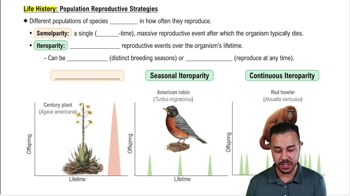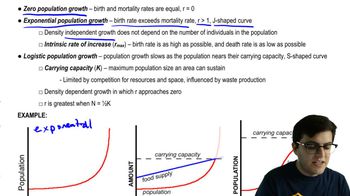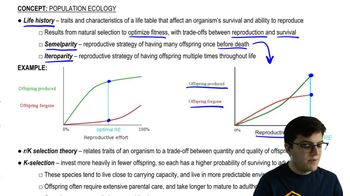Table of contents
- 1. Introduction to Biology2h 40m
- 2. Chemistry3h 40m
- 3. Water1h 26m
- 4. Biomolecules2h 23m
- 5. Cell Components2h 26m
- 6. The Membrane2h 31m
- 7. Energy and Metabolism2h 0m
- 8. Respiration2h 40m
- 9. Photosynthesis2h 49m
- 10. Cell Signaling59m
- 11. Cell Division2h 47m
- 12. Meiosis2h 0m
- 13. Mendelian Genetics4h 41m
- Introduction to Mendel's Experiments7m
- Genotype vs. Phenotype17m
- Punnett Squares13m
- Mendel's Experiments26m
- Mendel's Laws18m
- Monohybrid Crosses16m
- Test Crosses14m
- Dihybrid Crosses20m
- Punnett Square Probability26m
- Incomplete Dominance vs. Codominance20m
- Epistasis7m
- Non-Mendelian Genetics12m
- Pedigrees6m
- Autosomal Inheritance21m
- Sex-Linked Inheritance43m
- X-Inactivation9m
- 14. DNA Synthesis2h 27m
- 15. Gene Expression3h 20m
- 16. Regulation of Expression3h 31m
- Introduction to Regulation of Gene Expression13m
- Prokaryotic Gene Regulation via Operons27m
- The Lac Operon21m
- Glucose's Impact on Lac Operon25m
- The Trp Operon20m
- Review of the Lac Operon & Trp Operon11m
- Introduction to Eukaryotic Gene Regulation9m
- Eukaryotic Chromatin Modifications16m
- Eukaryotic Transcriptional Control22m
- Eukaryotic Post-Transcriptional Regulation28m
- Eukaryotic Post-Translational Regulation13m
- 17. Viruses37m
- 18. Biotechnology2h 58m
- 19. Genomics17m
- 20. Development1h 5m
- 21. Evolution3h 1m
- 22. Evolution of Populations3h 52m
- 23. Speciation1h 37m
- 24. History of Life on Earth2h 6m
- 25. Phylogeny2h 31m
- 26. Prokaryotes4h 59m
- 27. Protists1h 12m
- 28. Plants1h 22m
- 29. Fungi36m
- 30. Overview of Animals34m
- 31. Invertebrates1h 2m
- 32. Vertebrates50m
- 33. Plant Anatomy1h 3m
- 34. Vascular Plant Transport2m
- 35. Soil37m
- 36. Plant Reproduction47m
- 37. Plant Sensation and Response1h 9m
- 38. Animal Form and Function1h 19m
- 39. Digestive System10m
- 40. Circulatory System1h 57m
- 41. Immune System1h 12m
- 42. Osmoregulation and Excretion50m
- 43. Endocrine System4m
- 44. Animal Reproduction2m
- 45. Nervous System55m
- 46. Sensory Systems46m
- 47. Muscle Systems23m
- 48. Ecology3h 11m
- Introduction to Ecology20m
- Biogeography14m
- Earth's Climate Patterns50m
- Introduction to Terrestrial Biomes10m
- Terrestrial Biomes: Near Equator13m
- Terrestrial Biomes: Temperate Regions10m
- Terrestrial Biomes: Northern Regions15m
- Introduction to Aquatic Biomes27m
- Freshwater Aquatic Biomes14m
- Marine Aquatic Biomes13m
- 49. Animal Behavior28m
- 50. Population Ecology3h 41m
- Introduction to Population Ecology28m
- Population Sampling Methods23m
- Life History12m
- Population Demography17m
- Factors Limiting Population Growth14m
- Introduction to Population Growth Models22m
- Linear Population Growth6m
- Exponential Population Growth29m
- Logistic Population Growth32m
- r/K Selection10m
- The Human Population22m
- 51. Community Ecology2h 46m
- Introduction to Community Ecology2m
- Introduction to Community Interactions9m
- Community Interactions: Competition (-/-)38m
- Community Interactions: Exploitation (+/-)23m
- Community Interactions: Mutualism (+/+) & Commensalism (+/0)9m
- Community Structure35m
- Community Dynamics26m
- Geographic Impact on Communities21m
- 52. Ecosystems2h 36m
- 53. Conservation Biology24m
50. Population Ecology
Introduction to Population Ecology
Problem 5c
Textbook Question
Textbook QuestionWhich of the following species is most likely to have a Type III survivorship curve? a. humans, Homo sapiens b. common lizards, Zootoca vivipara c. thale cress plants, Arabidopsis thaliana d. lynx cats, Lynx canadensis
 Verified step by step guidance
Verified step by step guidance1
Understand the concept of survivorship curves: Survivorship curves are graphs that show the proportion of individuals surviving at each age for a given species or group. Type III survivorship curves are characterized by high mortality rates early in life, with few individuals surviving to adulthood.
Analyze the options by considering their life history traits: Species with a Type III curve typically produce many offspring but provide little or no care, resulting in high juvenile mortality.
Evaluate each species: a. Humans (Homo sapiens) typically have low mortality rates in early life and provide extensive parental care, indicative of a Type I survivorship curve. b. Common lizards (Zootoca vivipara) might seem a likely candidate, but they exhibit some parental care and have a relatively moderate juvenile mortality. c. Thale cress plants (Arabidopsis thaliana) produce a large number of seeds with minimal investment in each, leading to high mortality rates in seedlings. d. Lynx cats (Lynx canadensis) have moderate parental care and juvenile survival rates, not fitting the high early mortality of Type III curves.
Conclude the most likely candidate: Based on the characteristics of Type III curves and the life history traits of the given options, thale cress plants (Arabidopsis thaliana) are most likely to exhibit a Type III survivorship curve due to their reproductive strategy of producing many seeds with high early life mortality.
Final answer: c. thale cress plants, Arabidopsis thaliana
Recommended similar problem, with video answer:
 Verified Solution
Verified SolutionThis video solution was recommended by our tutors as helpful for the problem above
Video duration:
1mPlay a video:
Was this helpful?
Key Concepts
Here are the essential concepts you must grasp in order to answer the question correctly.
Survivorship Curves
Survivorship curves are graphical representations that show the number of individuals surviving at each age for a given species. They are categorized into three types: Type I, Type II, and Type III. Type III curves typically indicate high mortality rates in early life stages, with few individuals surviving to adulthood, which is common in species that produce many offspring.
Recommended video:
Guided course

Survivorship Curves
Type III Survivorship
Type III survivorship is characterized by a high number of offspring with low survival rates during early life. Species exhibiting this curve often invest little parental care, leading to a strategy where many offspring are produced to ensure that at least some survive to maturity. This strategy is common in organisms like plants and certain fish, which produce large quantities of seeds or eggs.
Recommended video:
Guided course

Survivorship
Reproductive Strategies
Reproductive strategies refer to the methods by which species reproduce and raise their young, influencing their survivorship curves. Species can be classified as r-selected, which produce many offspring with low survival rates (Type III), or K-selected, which produce fewer offspring with higher survival rates (Type I). Understanding these strategies helps in predicting the survivorship patterns of different species.
Recommended video:
Guided course

Life History: Population Reproductive Strategies

 1:17m
1:17mWatch next
Master Population Ecology with a bite sized video explanation from Jason Amores Sumpter
Start learningRelated Videos
Related Practice


































































